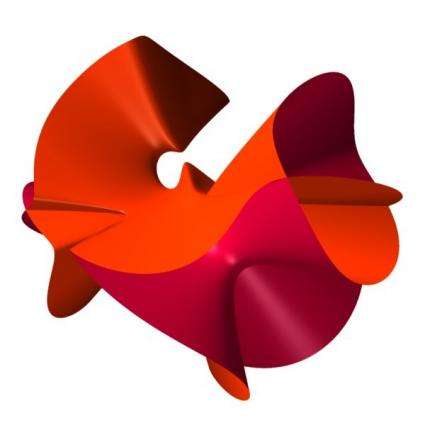Periodic table of shapes to give a new dimension to maths (w/ Video)

(PhysOrg.com) -- Mathematicians are creating their own version of the periodic table that will provide a vast directory of all the possible shapes in the universe across three, four and five dimensions, linking shapes together in the same way as the periodic table links groups of chemical elements.
The three-year project, announced today, should provide a resource that mathematicians, physicists and other scientists can use for calculations and research in a range of areas, including computer vision, number theory, and theoretical physics.
The researchers, from Imperial College London and institutions in Australia, Japan and Russia, are aiming to identify all the shapes across three, four and five dimensions that cannot be divided into other shapes - examples of which are in the above slideshow.
As these building block shapes are revealed, the mathematicians will work out the equations that describe each shape and through this, they expect to develop a better understanding of the shapes’ geometric properties and how different shapes are related to one another. The work is funded by the Engineering and Physical Sciences Research Council, the Leverhulme Trust, the Royal Society and the European Research Council.
Project leader Professor Alessio Corti, from the Department of Mathematics at Imperial College London, explained: "The periodic table is one of the most important tools in chemistry. It lists the atoms from which everything else is made, and explains their chemical properties. Our work aims to do the same thing for three, four and five- dimensional shapes – to create a directory that lists all the geometric building blocks and breaks down each one’s properties using relatively simple equations. We think we may find vast numbers of these shapes, so you probably won’t be able to stick our table on your wall, but we expect it to be a very useful tool."
The scientists will be analysing shapes that involve dimensions that cannot be 'seen' in a conventional sense in the physical world. In addition to the three dimensions of length, width and depth found in a three-dimensional shape, the scientists will explore shapes that involve other dimensions. For example, the space-time described by Einstein’s Theory of Relativity has four dimensions – the three spatial dimensions, plus time. String theorists believe that the universe is made up of many additional hidden dimensions that cannot be seen.
Professor Corti's colleague on the project, Dr Tom Coates, has created a computer modelling programme that should enable the researchers to pinpoint the basic building blocks for these multi-dimensional shapes from a pool of hundreds of millions of shapes. The researchers will be using this program to identify shapes that can be defined by algebraic equations and that cannot be divided any further. They do not yet know how many such shapes there might be. The researchers calculate that there are around 500 million shapes that can be defined algebraically in four dimensions and they anticipate that they will find a few thousand building blocks from which all these shapes are made.

Dr. Coates, from the Department of Mathematics at Imperial College London, added: "Most people are familiar with the idea of three- dimensional shapes, but for those who don't work in our field, it might be hard to get your head around the idea of shapes in four and five dimensions. However, understanding these kinds of shapes is really important for lots of aspects of science. If you are working in robotics, you might need to work out the equation for a five dimensional shape in order to figure out how to instruct a robot to look at an object and then move its arm to pick that object up. If you are a physicist, you might need to analyse the shapes of hidden dimensions in the universe in order to understand how sub-atomic particles work. We think the work that we're doing in our new project will ultimately help our colleagues in many different branches of science.
"In our project we are looking for the basic building blocks of shapes. You can think of these basic building blocks as 'atoms', and think of larger shapes as ‘molecules.’ The next challenge is to understand how properties of the larger shapes depend on the 'atoms' that they are made from. In other words, we want to build a theory of chemistry for shapes," added Dr. Coates.
Dr Coates has recently won a prestigious Philip Leverhulme Prize worth £70,000 from the Leverhulme Trust, providing some of the funding for this project. Philip Leverhulme prizes are awarded to outstanding scholars under the age of 36 who have "made a substantial contribution to their particular field of study, recognized at an international level, and where the expectation is that their greatest achievement is yet to come."
More information: Researcher's blog: coates.ma.ic.ac.uk/fanosearch/
Provided by Imperial College London


















